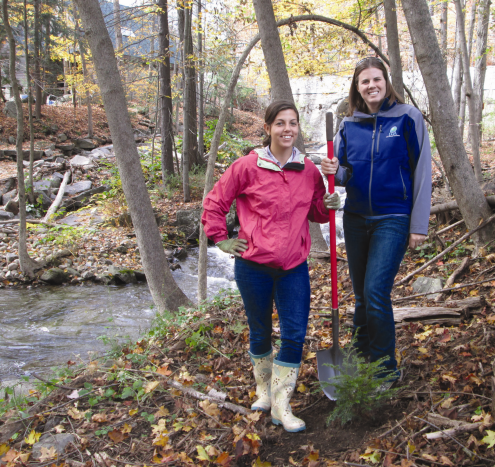
LGA staff members Jill Trunko (left) and Emily DeBolt (right) stand near a newly planted eastern hemlock that is part of a new vegetative buffer along English Brook in Lake George. The buffer included 120 plants, funded through the DEC’s Trees for Tribs program.
This October, the LGA joined several partners to plant dozens of native plants and shrubs along English Brook near its mouth at Lake George.
“When the subdivision at Lochlea was created,” said Tom Jarrett, one of the LGA members involved in the project, “a 50 ft. vegetative buffer was designated along the brook. This buffer requirement is being honored during construction of Dan Dwyer’s property on the brook, but we thought we could do more.”
“The existing buffer on the property benefited greatly from some supplemental planting,” said LGA Education Director Emily DeBolt. “The existing under-story was pretty sparse, and since English Brook is one of the larger tributaries to the lake, we wanted to help improve the buffer to protect the stream, and ultimately the lake. We decided to see if we could get some funding from a DEC program called Trees for Tribs, and we were successful,” she said.
The Trees for Tribs program is run by the DEC’s State Tree Nursery at Saratoga, which supplies the plants for the program. Trees for Tribs is part of a DEC initiative to restore and protect stream-side forests in the Lake Champlain Watershed. The program offers free native trees and shrubs for qualifying riparian buffer projects.
The LGA, Lake Champlain Lake George Regional Planning Board, Jarrett Engineers PLLC, and local property owners at the Lochlea estate worked together on the project. Along English Brook and the Dwyer’s property, 120 native plants and shrubs were planted, including arrowwood, red twig dogwood, red oak, high bush cranberry, eastern hemlock and more.
